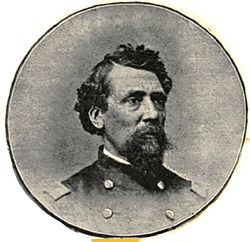| Thomas Allcock | |
|---|---|
 Thomas Allcock with the 4th New York Heavy Artillery Thomas Allcock with the 4th New York Heavy Artillery | |
| Born | 27 January 1815 Birmingham, England |
| Died | 28 December 1891(1891-12-28) (aged 76) New York City, U.S. |
| Buried | Dale Cemetery Ossining, New York |
| Allegiance | United States Union |
| Service | United States Army Union Army |
| Years of service | 1861–1866 |
| Rank | |
| Unit | 4th New York Heavy Artillery Regiment |
| Battles / wars | See list |
| Other work | inventor, founder of the Allcock Manufacturing Company |
Thomas Allcock (1815–1891) was the inventor of a plaster for pain relief, the founder of the Allcock Manufacturing Company and an artillery officer in the Union Army during the American Civil War. He was one of the military judges in the trial of Henry Wirz.
Early life
Allcock was born and educated in Birmingham, England. At age 15, he studied and practiced chemistry. Allcock emigrated to the United States in 1845, settled in New York and opened a small drug store under the Astor House. In 1854, he invented a porous plaster for the relief of pain, the sale of which made an appreciable increase in his income. Subsequently formed Allcock Manufacturing.
Military career
Allcock joined the New York State Militia, and was appointed Captain on 27 October 1856 with the Second Brigade, a post he held until the outbreak of the American Civil War. Allcock was made Assistant Adjutant General on 13 April 1861, headquartered in the New York Depot. On January 4, 1862, he mustered with the 4th New York Heavy Artillery as major.
Allcock was engaged in the battles of the Wilderness, Spotsylvania, North Anna, Totopotomoy, Hanover Court House, Cold Harbor, Petersburg, first and second Deep Bottom, Weldon Railroad, and Ream's Station. Allcock was wounded while in command of the Third Battalion at the First Battle of Ream's Station on 25 August 1864, for which he was appointed brevet colonel. Allcock was on detached duty as an invalid from September 1864 to December 2, 1865 when he was discharged due to the end of the war.
On February 21, 1866, President Andrew Johnson nominated Allcock to the grade of brevet brigadier general of volunteers, to rank from March 13, 1865, and the United States Senate confirmed the nomination on April 10, 1866. Allcock returned to New York after the war and joined up with Benjamin Brandreth in the manufacturing and sale of popular patent medicines.
Death
Thomas Allcock died on 27 December 1891, in New York City, of a stroke. He was buried at Dale Cemetery in Ossining, New York. He was survived by two sons and two daughters.
References
- Citations
- "gen_cw_factsfiguresmyths1921_0014". digital.ncdcr.gov. Retrieved 2023-03-03.
- ^ Johnson 1906, p. 79
- Kirk, Hyland C. (1890). Heavy Guns and Light: A History of the 4th New York Heavy Artillery. New York, NY: C.T. Dillingham. p. 447. Retrieved 21 April 2009.
- ^ Eicher & Eicher 2001, p. 101
- Eicher & Eicher 2001, p. 739
- "Gen. Thomas Allcock Dead". New York Times. 28 December 1891. Retrieved 21 April 2009.
- Sources
- Eicher, John H.; Eicher, David J. (2001). Civil War High Commands. Stanford: Stanford University Press. pp. 101 & 739. ISBN 978-0-8047-3641-1.
 This article incorporates text from a publication now in the public domain: Johnson, Rossiter, ed. (1906). "Allcock, Thomas". The Biographical Dictionary of America. Vol. 1. Boston: American Biographical Society. p. 79.
This article incorporates text from a publication now in the public domain: Johnson, Rossiter, ed. (1906). "Allcock, Thomas". The Biographical Dictionary of America. Vol. 1. Boston: American Biographical Society. p. 79.